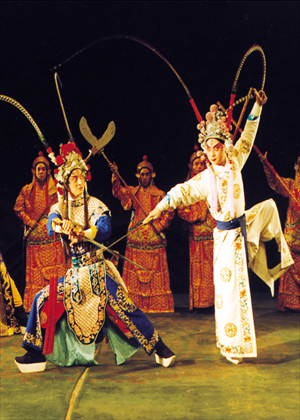|
Literature and Art
(Hebei Online)
Updated: 2004-07-15 13:48
Literature
The literature composition of Hebei Province has always been occupying a comparatively important position in the country. Th the early period of the founding of new China, the literary works mainly reflected the history of people's hard struggle in the Liberation War. Representative works of that period include Keep the Red Flag Flying of Liangbin; Stormy Years of Sunli; Raging Fire and Warrior Attendant of Liuliu; Armed Working Team at Enemy's Rear Area of Fengzhi; and Little Soldier of Zhangga of Xu Guangyao.
After the reform and opening-up to the outside world, new period of literary composition started and a group of young writers with Tiening as the representative appeared. It is worth mentioning that Heshen, Tange and Guan Renshan, who have been called "Three Horse-drawn Carriages", have produced a series of new-realism novels aiming at closing to the reality.
Calligraphy
Chinese characters were gradually evolved from drawings and symbols, and the handwriting developed into and independent art during the course. All the calligraphist rely on are mere paper, pen, writing brush and ink, and what they reveal are only some lines, yet they can vary so many different artistic styles. Not many people are using writing brushes in nowadays, however, the number of those who regard calligraphy as an art and keep practicing writing with brushes have never decreased.
People are all hoping to manifest the elegant and graceful demeanour of the Chinese calligraphy by writing the characters regularly and beautifully. Speaking of the calligraphist in Hebei, the name of HuangQi comes first on the list. He created by himself the "tiejimosha" style which had drawn the attention of the country and also had a certain influence in Japan. In addition, the running-hand and cursive-script of Xiong Renwang, Humin and Pan Xuecong; the official script (an ancient style of calligraphy, current in Han Dynasty) of Ou Yangda and the Dazhuan (an ancient style current in Zhou Dynasty) of Wang Muyi all enjoy great fame.
Painting
The traditional Chinese paintings all have the same conspicuous characteristic: combining the poem, calligraphy and drawing all in one.
The paintings are often inscribed with poems to enrich its beauty and charm. Tian Xinfu, who had ever followed Bai Shouzhang to learn his freehand brushwork of flowers and birds, absorbed the advantageous qualities from different classes and created his own special style in his later years.
Modern painters specialize in even more specific aspects, some of them only draw pictures of the traditional beautiful women, and some only concentrate in painting a special kind of animal such as cat, donkey or horse. For instance, Hebei painter Quan Zhuming is very famous for drawing donkeys. Hanyu, another painter is well known by his caricatures and paintings about characters from operas. His characters are ingeniously conceived, exaggeratedly modeled and full of charm. Oil painting, printed painting and watercolor painting other than the traditional Chinese painting have also developed very fast in Hebei.
Operas

|
There are more than 300 types of local operas in China, and the most influential and widely spread one of them is Peking Opera. It is a kind of stage craft that combines singing, dancing performance and skill all together in a great harmony. Hebei has 26 types of local operas with Hebei Clapper Opera and Ping Opera (a local opera of north and northeast China) as the most important ones, and the later one has become one of the major national operas.
Ping Opera originated from the Yangge, a folk song and dance drama popular in northeast China that is one of the main activities on the lunar New Year's flower fairs.
The typical pattern of Yangge is that a pair of dancers accompanied by a group of people singing and dancing around, and also with the accompany of gongs and drums, horns, or traditional stringed and woodwind instruments. It mainly tells the folktales about the people's life, historical figures and sceneries of the four seasons. Pei Yanling, a singer of Hebei Clapper Opera, has won the "Plum Blossom Award" twice, which represents the highest award of the opera performance in the country.
Cinemindustry
The film industry of Hebei has greeted an ever active high tide since 1978, fine works have constantly emerged such as "Sister and Brother From Afar", "Family Affairs in Li Xioae's", and TV dramas as "The Deity of Zhongkui" and "Black Face".
"Dance In A Circle" is an excellent musical film that rarely seen in recent movie circle of China. Entering into 90's, cinema workers of Hebei constantly changed their ideas and means of artistic expression and carried out reforms in filming, film distribution and film projection.
The preliminary establishment of the independent producer system has changed the situation in 80's that the state investment occupied the leading position and made the investment in cinemindustry rationalized, the fund-collection more diversified and the range of subjects much wider. Then other characteristic of the film economy in 90's is the importation of foreign top movies, which not only aroused the interests of the audience, but also increased the whole box-office value.
|